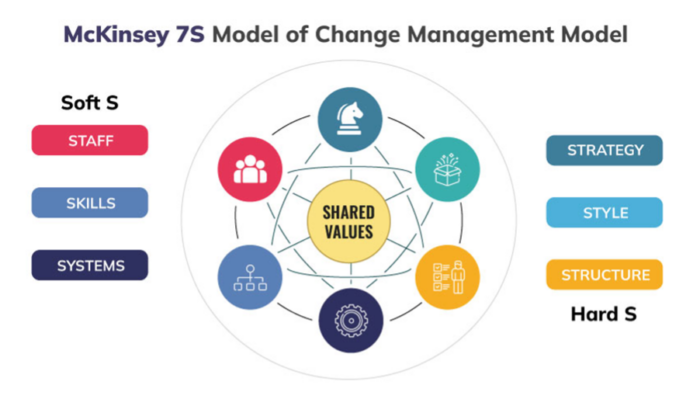CICERO PERSPECTIVE
How AI Impacts Each of McKinsey’s 7-S Framework Elements
What to consider
By: Niko Zona
Within business strategy, McKinsey’s 7-S Framework remains a cornerstone. Introduced in the 1970s by Robert Waterman and Tom Peters, this model emphasized the importance of coordinated efforts across seven crucial elements for organizational effectiveness. Fast forward to today, and the landscape is drastically different, thanks to the advent of Artificial Intelligence (AI). Let’s dive into how AI reshapes each of the seven elements of McKinsey’s framework.
In the digital age, strategic planning has undergone a fundamental shift. No longer confined to long-term forecasts, modern strategy leverages AI for agile, data-driven decision-making. AI tools analyze vast datasets with speed and accuracy, providing real-time insights into market trends and consumer behaviors. This capability allows organizations to continuously refine their strategies, ensuring they remain at the forefront of their industries.
AI’s impact extends beyond reactive analysis, enabling proactive strategic planning. Through advanced scenario modeling and simulations, businesses can predict outcomes for various initiatives, significantly reducing risks and optimizing opportunities. Moreover, AI-driven insights uncover emerging markets and customer segments, empowering organizations to swiftly adjust their strategies and capitalize on new prospects. By harnessing these AI capabilities, companies can navigate the complexities of today’s business landscape with greater confidence and agility.
Strategy Tool Examples:
- Alteryx: A data analytics platform that leverages AI to transform data into actionable insights, helping businesses formulate and adjust their strategies.
- Sisense: An AI-powered business intelligence tool that provides advanced analytics and data visualization to support strategic decision-making.
- Qlik Sense: Utilizes AI to offer self-service data analytics and business intelligence, enabling organizations to make informed strategic decisions based on real-time data.
Structure
AI is reshaping organizational structures, transforming traditional hierarchies into more adaptive, dynamic systems. By harnessing AI-powered automation and intelligent analytics, companies can flatten their structures, boosting both efficiency and innovation. This shift empowers employees across all levels to engage in decision-making, fostering a more agile and inclusive organizational culture that’s better equipped to navigate today’s rapidly changing business landscape.
The integration of AI facilitates decentralized decision-making by providing teams throughout the organization with real-time data and insights. This democratization of information enables local units to make timely, informed decisions, enhancing overall responsiveness and adaptability. Additionally, AI’s capacity to identify structural inefficiencies and propose optimizations leads to more effective resource allocation and organizational design. By leveraging these AI-driven capabilities, businesses can create more flexible, efficient, and responsive organizational structures poised for success in an increasingly complex market environment.
Structure Tool Examples:
- OrgVue: AI-driven organizational design and workforce planning tool that helps companies model and visualize their structure.
- Workday Adaptive Planning: Facilitates dynamic organizational planning, structure alignment, and scenario modeling.
- Lucidchart: An intelligent diagramming application that helps in visualizing and optimizing organizational structures and processes.
Systems
Systems have always been the backbone of operational efficiency. With AI, these systems become smarter and more efficient. AI-powered systems can automate routine tasks, optimize workflows, and provide predictive maintenance, thereby reducing downtime and increasing productivity. This intelligent automation allows human resources to focus on more strategic initiatives.
For example, AI can enhance supply chain management by predicting demand, optimizing inventory levels, and identifying potential disruptions before they occur. In customer service, AI-powered chatbots and virtual assistants can handle routine inquiries, freeing up human agents to address more complex issues. Additionally, AI can improve cybersecurity systems by detecting and responding to threats in real-time, ensuring the protection of sensitive data.
Systems Tool Examples:
- Automation Anywhere: A comprehensive RPA tool that uses AI to automate complex business processes, enhancing efficiency and reducing manual workload.
- Blue Prism: Another leading RPA tool that integrates AI to streamline and automate business processes, providing scalable solutions for various industries.
- Kofax: Uses AI and machine learning to automate document-intensive processes, improve workflow, and enhance overall system efficiency.
Shared Values
Shared values form the core of an organization’s culture. AI can help reinforce these values by promoting transparency and ethical behavior. For instance, AI-driven analytics can monitor compliance with corporate values and highlight areas of concern. Additionally, AI can assist in maintaining a diverse and inclusive workplace by mitigating biases in recruitment and promotion processes.
AI can also support corporate social responsibility initiatives. By analyzing environmental impact data, AI can help organizations reduce their carbon footprint and promote sustainability. Furthermore, AI can enhance employee engagement by providing personalized experiences and feedback, ensuring that the organization’s values resonate with its workforce.
Shared Values Tool Examples:
- Culture Amp: Employee feedback and analytics platform that uses AI to measure and enhance company culture and shared values.
- Peakon: AI-driven employee engagement platform that provides insights into cultural values and employee sentiment.
- Quantum Workplace: Uses AI to analyze employee feedback and identify trends related to organizational culture and values.
Style
Management style is crucial in shaping organizational culture. AI can support a more inclusive and participative leadership style by providing leaders with real-time feedback and insights into employee sentiment. This helps leaders make informed decisions, address concerns promptly, and create a more engaging and supportive work environment.
AI can also enhance leadership development by identifying potential leaders within the organization and providing personalized training and development programs. By analyzing performance data, AI can highlight areas where leaders excel and where they need improvement, enabling targeted development efforts. Additionally, AI can facilitate better communication and collaboration among leadership teams, ensuring alignment with organizational goals and values.
Style Tool Examples:
- TINYpulse: AI-powered employee engagement platform that provides real-time feedback and insights into management styles and their impact.
- Glint: Uses AI to provide insights into leadership effectiveness and employee engagement, helping shape management styles.
- Officevibe: AI-driven tool that offers continuous feedback and insights into leadership effectiveness and organizational climate.
Staff
The composition and motivation of the workforce are pivotal. AI revolutionizes talent management by enhancing recruitment processes, identifying skill gaps, and personalizing employee development programs. AI-driven tools can predict the potential of employees, ensuring the right talent is in the right roles, thus boosting overall organizational performance.
AI-powered recruitment platforms can analyze resumes, conduct initial screenings, and even predict candidate success based on historical data. This speeds up the hiring process and ensures a better fit between candidates and roles. Once onboard, AI can personalize training programs to match individual learning styles and career aspirations, enhancing employee engagement and retention.
Staff Tool Examples:
- Workday HCM: An AI-powered human capital management (HCM) platform that helps with talent acquisition, development, and management, providing insights into employee performance and engagement.
- Lattice: A performance management tool that uses AI to provide feedback, goal-setting, and performance review processes, enhancing overall employee development and satisfaction.
- Cornerstone OnDemand: An AI-driven platform for talent management that includes learning, performance, and recruiting modules to help organizations manage their workforce more effectively.
Skills
In the age of AI, the importance of skills cannot be overstated. AI helps identify emerging skill requirements and provides personalized learning pathways to upskill employees. Continuous learning supported by AI ensures that the workforce remains competitive and adept at handling new technologies, driving innovation and growth.
AI can facilitate skills assessments by analyzing employee performance data and identifying gaps. This enables organizations to design targeted training programs that address specific needs. Moreover, AI can support lifelong learning by recommending relevant courses, workshops, and resources based on individual career goals and industry trends. This continuous development ensures that employees remain valuable assets to the organization.
Skills Tool Examples:
- LinkedIn Learning: AI-powered learning platform that provides personalized course recommendations based on skill gaps and career goals.
- Coursera for Business: Utilizes AI to offer tailored learning paths and skills assessments for employees.
- Skillsoft Percipio: AI-driven learning platform that identifies skill gaps and provides personalized learning experiences to bridge them.
Implementing the 7-S Model with AI
To harness the full potential of AI within the 7-S Framework, organizations must adopt a holistic approach:
- Identify Gaps: Use AI analytics to conduct a thorough analysis of current business processes, identifying gaps and areas for improvement.
- Organizational Design: Leverage AI-driven insights to design an optimal organizational structure that aligns with both management’s vision and employee sentiments.
- Action Plan: Develop a detailed action plan using AI tools to streamline changes in hierarchy, communication flows, and reporting relationships.
- Change Implementation: Utilize AI to manage change initiatives effectively, ensuring minimal resistance and maximum engagement.
- Continuous Review: Employ AI for continuous monitoring and assessment of the seven elements, maintaining momentum and ensuring ongoing alignment with organizational goals.
Conclusion
AI is not just a technological advancement; it’s a transformative force that impacts every aspect of an organization. By integrating AI into McKinsey’s 7-S Framework, businesses can achieve unprecedented levels of efficiency, adaptability, and growth. Embrace AI to not only stay relevant but to thrive in the competitive landscape of the future. The integration of AI into each element of McKinsey’s framework underscores the importance of a holistic approach to change management, ensuring that every aspect of the organization evolves in harmony.
At the end of the day, change must come from you and your employees. Ensure the human touch and input are not overlooked. People utilizing new tools can unlock your next level of success.

Start a Conversation
Thank you for your interest in Cicero Group. Please select from the options below to get in touch with us.
